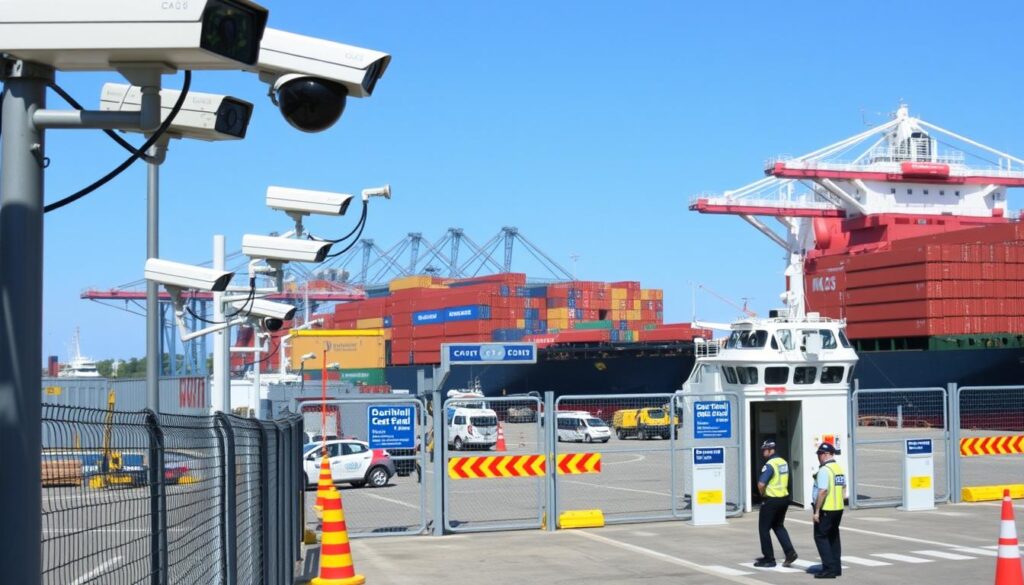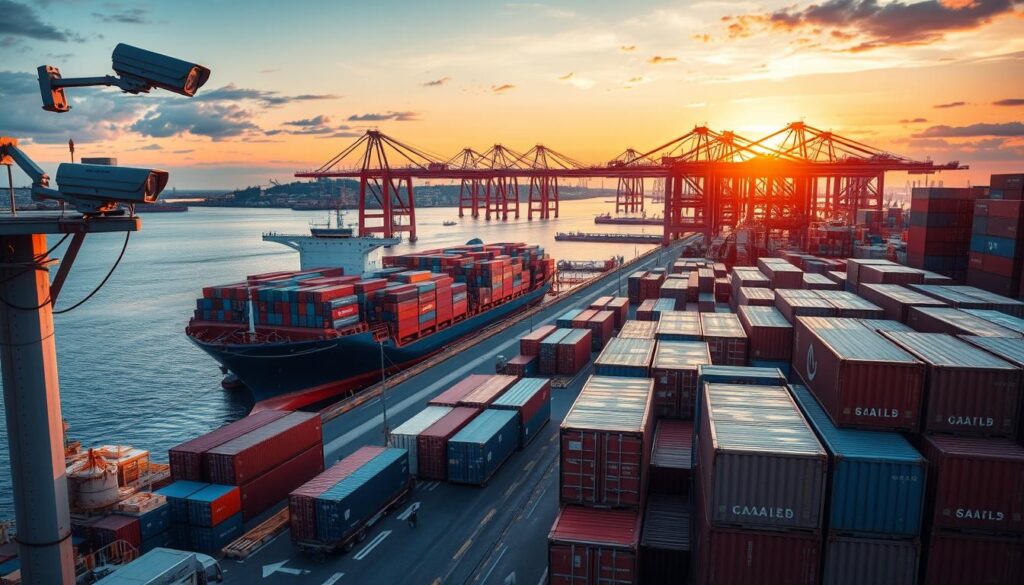Keeping ports safe is key for global trade, as 90% of the world’s goods move by sea. But why is port security so important? How do we keep these vital spots safe? Let’s dive into the world of port security and its big impact on our global economy.
Port security means using many measures to protect ports from threats like terrorism and piracy. It also covers the safety of marine areas and coastlines. With ports being big and open, keeping them safe is essential to keep goods moving worldwide.
Key Takeaways
- Port security is crucial for keeping global trade flowing smoothly, mainly by sea.
- Good port security uses many layers, like access control and surveillance, to keep things safe.
- Following international rules, like the ISPS Code, and working together are key for strong port security worldwide.
- New threats, like cyber attacks and piracy, show we must always update our port security.
- Investing in port security makes it safer and helps protect the environment from big spills.
What are Port Security Measures?
Port security is about keeping a shipping port safe from terrorism and illegal activities. It also makes sure the port follows international maritime rules. This is key to maritime security, which protects ships, coastlines, and marine areas.
Definition and Overview
Maritime security guards against threats like terrorism and environmental harm. Port security measures keep facilities, cargo, and people safe. They follow the International Ship and Port Facility Security (ISPS) Code and other global rules.
- The ISPS Code, set up in 2004, is a must for international shipping. It has rules for governments, port authorities, and shipping companies.
- Security officers like Port Facility Security Officers (PFSOs) and Ship Security Officers (SSOs) create and carry out security plans. They handle risks.
- The ILO/IMO Code of Practice on Security in Ports, approved in 2004, helps the ISPS Code. It focuses on security in the port area.

Port security is vital for safe maritime operations. It fights threats and follows global rules.
Key Aspects of Port Security
International Regulations and Standards
Port security follows global rules like the International Ship and Port Facility Security Code (ISPS). This code is set by the International Maritime Organization (IMO). It sets out safety and security standards for the world’s seas.
In the U.S., programs like the Container Security Initiative (CSI) and the Customs-Trade Partnership against Terrorism (CTPT) boost port safety. They work together with the private sector and government agencies.
Access Control and Surveillance
Good port security needs strong access control and surveillance. Physical barriers, like security guards and cameras, keep unwanted visitors out. Advanced tech, like drones and facial recognition, helps spot threats early.
Cargo checks are also key. X-ray machines and sniffer dogs find hidden dangers or illegal goods.
With ports going digital, keeping them safe from cyber attacks is vital. Port authorities and operators must protect against malware and cyber threats.
| Security Measure | Description |
|---|---|
| Physical Security | Security guards, video surveillance, alarm systems |
| Cargo Screening | X-ray machines, sniffer dogs |
| Cybersecurity | Malware detection, network monitoring, access controls |
Good communication and translation services are also important. They help ensure smooth and safe port operations. Interpreters help in emergency situations by breaking down language barriers.

Port Security Measures and Maritime Security
Maritime security is key to protecting oceans, territorial waters, and ports from crimes like piracy and pollution. The European Union’s maritime security strategy (EUMSS) is a joint effort to tackle these issues. It aims to make seas safer, which in turn makes land safer.
The maritime industry is vital for global trade, handling about 90% of it. Yet, it faces big risks like cargo theft, costing the U.S. economy $15 to $35 billion a year. Piracy and armed robbery at sea are also threats, with 115 incidents reported in 2022.
Port security measures have been put in place to fight these threats. The International Ship and Port Facility Security (ISPS) Code, the Long-Range Identification and Tracking (LRIT) system, and the Maritime Transportation Security Act (MTSA) of 2002 are some of them. These rules help improve security, fight terrorism, and stop other illicit activities at sea.
- The ISPS Code, adopted in 2002 and implemented in 2004, sets security standards for ships and ports to prevent and handle security incidents.
- The LRIT system, under the SOLAS Convention, tracks ships worldwide, boosting maritime awareness.
- The MTSA of 2002 made security in the marine transportation system a national and global priority, leading to new regulations in 2004.
These port security measures, along with maritime strategies, are crucial for the global maritime industry. They protect the industry, its infrastructure, and the environment from threats. By ensuring safer seas and better coastal protection, these efforts help the maritime industry and the global economy thrive.

Importance of Port Security
The maritime cargo industry is key to global trade, with billions of tonnes of cargo moving through ports each year. In 2019, EU sea ports handled 3.6 billion tonnes of freight. The UK saw 486.1 million tonnes, and the US moved 55.5 million cargo units. Despite a 4.1% drop in 2020 due to COVID-19, port security is still crucial.
Economic Impact
Good port security is vital for the maritime cargo industry’s safety and its economic impact. Companies can’t afford losses from port crimes like theft or vandalism. With strong security, ports keep goods moving, protecting the global supply chain and boosting the economy.
Environmental Protection
Strong port security also helps protect the environment. It prevents oil spills and other disasters that harm ecosystems. By securing ports, we reduce the risk of such incidents, helping the maritime industry stay sustainable.

As maritime trade grows, so does the need for port security. By focusing on security, ports can move goods efficiently and safely. This supports both economic growth and environmental protection.
Challenges and Emerging Threats
The maritime industry is facing many challenges and new threats. One big worry is piracy. It’s happening in places like the Gulf of Guinea and the South China Sea. Pirates are targeting ships and cargo, putting crew members at risk and messing up global trade.
Cybercrime is another big problem. With more automation and digital systems, ships are getting hacked. It’s important to protect data and keep systems safe from cyber attacks.
There are also maritime security threats like drug and weapon smuggling. These crimes harm ports and the economy, and can also hurt the environment.
| Challenge | Impact |
|---|---|
| Piracy | Disruption of global trade and supply chains, as well as the safety of crew members. |
| Cybercrime | Vulnerability of automated systems and data, leading to potential breaches and financial losses. |
| Maritime Crime | Illicit trafficking of goods, undermining the integrity of port operations and causing economic and environmental harm. |
The maritime industry must stay alert and ready to face these challenges. By tackling these threats and improving security, it can keep the global economy safe and protect communities.
Best Practices and Industry Standards
In the world of maritime security, following best practices and standards is key. It ensures the safety and integrity of ports. Leading organizations offer insights and guidance to help ports and maritime operators stay safe.
The United States Coast Guard’s International Port Security Program has a wealth of security best practices. These come from facilities all over the world. They cover important areas like access control, communications, and training.
The Port Security Risk Assessment Tool (PSRAT) is another valuable resource. It helps government entities assess terrorism threats at ports. This tool is based on Microsoft Access and is very detailed.
Many ports also get compliance certifications like SOC2 Type II and ISO 27001:2022. These show they are serious about protecting data and following global rules.
| Best Practices and Standards | Key Features |
|---|---|
| Maritime Security Best Practices |
|
| Port Security Risk Assessment Tool (PSRAT) |
|
| Compliance Certifications |
|
By following port security best practices and maritime security standards, ports can get stronger. They can better face threats like cargo screening protocols and emergency response planning. This makes their operations safer.
Conclusion
Port security and maritime strategies are key to protecting our economy and environment. They keep vessels, cargo, and people safe. With 90% of goods shipped by sea, effective port security is crucial.
Good port security means following international rules and using the latest tech. This includes tracking systems, satellite comms, and cybersecurity. But, new threats like piracy and cyber attacks are rising. We must stay alert and use the best practices.
Strong port security is vital for a stable global trade and supply chain. By focusing on security, using new tech, and working together, we can keep our ports safe. This will help our economy grow and ensure a sustainable future.

This Article is Reviewed and Fact Checked by Ann Sarah Mathews
Ann Sarah Mathews is a Key Account Manager and Training Consultant at Rcademy, with a strong background in financial operations, academic administration, and client management. She writes on topics such as finance fundamentals, education workflows, and process optimization, drawing from her experience at organizations like RBS, Edmatters, and Rcademy.


